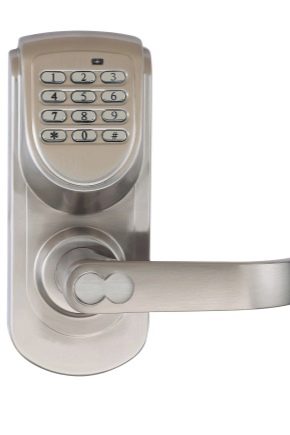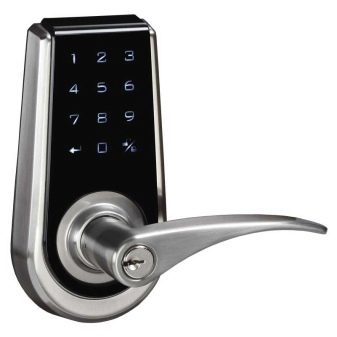Combination door lock: tips for choosing and using

Loss of a key is an eternal problem for owners of "ordinary" locks. The code variant does not have such a problem. But you still need to carefully choose such devices and strictly observe the requirements for their use.

Features and principle of operation
The essence of the combination lock is quite simple: you need to dial a strictly defined code to open the door. The difference between the individual types of devices has to do with how this feature is implemented.
It is customary to highlight:
- mechanical;


- electromechanical;


- electronic systems.


Regardless of this, the system will:
- the locking block itself;
- code receiver (or dialer);
- a control system that checks the correctness of the dialed digits (or design features of a mechanical lock that allow it to open only when they are correctly indicated);
- power supply unit (in electronic versions);
- backup make-up system (in electronic versions).

Advantages and disadvantages
The positive aspects of code-unlocked locks are:
- no need to have a key with you all the time;
- the inability to lose this key;
- the ability to replace a set of keys for a whole family or a group of people with one code.

Such devices are relatively inexpensive. It is very easy to change the code (if it is made public). You can also periodically, for prophylaxis, change the password to complicate the situation for intruders. But if they know the code, they can easily get inside. In addition, forgetting the password, the owners of the premises themselves will not be able to get into it so easily.
Varieties and subtleties of choice
There are many modifications of combination locks that can be installed on the front door. The installation method allows you to distinguish between hinged and mortise mechanisms. The hinged version is preferable for household objects. But to protect a residential building or office building, it is much better to use a mortise mechanism.
For your information: only mortise systems are used on driveways.



An electric door lock is considered more attractive than its mechanical counterpart. The latter has already been thoroughly studied by robbers and other criminals, therefore it does not represent a serious obstacle for them. In addition, the fewer moving parts, the lower the risk of breakage. Nevertheless, there is still a proposal for mechanical systems that can be unlocked when a code is entered. If you choose among them, then preference should be given to roller rather than push-button options.


The fact is that with active use, even the most durable buttons and inscriptions on them are overwritten. One glance is enough to determine which numbers are being pressed to access the inside.
And sometimes the buttons go down - that's when the owners of the house themselves will face problems. If the mechanism is made according to the roller scheme, then any number of its revolutions will not leave traces that issue an access code. Yet such a decision can only be viewed as a last resort.

Electronic locks, unlike mechanical ones, can be placed at an arbitrary point, even if it is removed from the devices that physically block the door. It is almost impossible to pick a lock if it is not clear exactly where it is located and how exactly it is arranged. Moreover, the selection of the code by the method of random typing is very difficult even with the use of laptops.
Choosing a push-button electronic lock, home owners are very risky - the problems with the keyboard are the same as with the mechanical method of setting the ciphers.

A more modern solution is devices with a code recorded on magnetic tapes. To present it to the reading unit, use an access card, key fob or remote control. But in all three cases, signal interception is possible. And if attackers seriously intend to get to a protected object, they will be able to decrypt any digital passwords. In addition, not even all professionals will undertake to install such locks.
Code devices with a sensor method for entering information are quite widespread. There is no need to use different types of touch screens for this purpose. Of course, such a solution is also possible. But another option is much more practical - in it the heads of decorative nails turn out to be sensory fields. Technically, the input of numbers is realized by means of alternating current pickups.




The disadvantage is obvious - such a system is operational only where there is wiring or, at least, a stable autonomous power supply. But this problem does not really matter. In any case, if there is an opportunity to buy a reliable door and a good lock, the power supply will be established.
If you choose a branded sensor device, you need to pay attention to how it fits into the design of the door and the surrounding space. This is important for both offices and residential buildings.
Noteworthy are not only touch locks, but also combination locks supplemented with crossbars. Most often, encoding is done using small discs. They are able to rotate around their own axis, however, there are a number of stable positions. Fixation in these positions is achieved by means of balls of a special kind. Special indentations on the discs are designed in such a way that it was impossible to pick up the code.



By opening the case, the owners gain access to the code knobs. These elements are responsible for password remapping. The bolt device is designed in such a way that the door can be closed both from the outside and from the inside.
Models with a deadbolt are preferred, the length of which is the same as the length of the body. Power breaking of such locks is as complicated as possible.
The experience of operating crossbar combination locks has shown that, for at least 15 years, they do not experience significant wear and tear. All basic protective functions are performed as reliably as they were immediately after installation. At the same time, respectable people who enter the code correctly do not experience any inconvenience when interacting with the old device.
Experts note that the chances of opening the door by drilling the mechanism are close to zero. Another hacking technique, using a stethoscope, is also extremely time consuming and unreliable from the burglar's point of view.

Application area
You can put a combination lock on the front door in a variety of places:
- in a private house and cottage;
- at the entrance of an apartment building;
- in the office;
- in a warehouse;
- at another facility where enhanced and reliable protection is required.
Where there is a large flow of people - in offices and porches, mechanical combination locks are often used. In these cases, the absence of the need for keys reduces the overall installation costs.
Mortise structures are used on doors, the thickness of the leaf of which varies from 3 to 6 cm. If it is less, enhanced code protection will not save you. If more, the job becomes overly complicated.

Overhead versions of locks are used for installation on the doors of secondary outbuildings. It is irrational to use them to restrict access to the apartment.
Combination locks can also be installed on interior wooden doors, but this option is not always advisable, because in the space of an apartment you can choose a simpler option.

Installation of the lock
Installation of a patch lock with coded unlocking provides only for fixing its body to the door.Following this, the counter panel (the crossbar will be placed in it when the passage is locked) is placed on the jamb. It will take no more than 15 minutes to complete all this.
It is much more difficult to install a mortise mechanical lock. First, markup is done using templates - they are made by hand or taken from the delivery kit.


Template markup can be done:
- marker;
- pencil;
- with an awl;
- chalk.
When everything is marked out, it should become clear - where it is necessary to cut the body of the lock itself, and where to insert the fasteners. A niche for the main part of the device is prepared with a drill and a chisel. Sometimes a special nozzle is used. At the same time, they make sure that the body is placed freely, but there are no slightest distortions. When this is done, the bolt holes must be drilled.
Where the crossbar is led out, a small recess is prepared. It must exactly match the size of the front panel. The panel is placed flush with the canvas. In other words, its deepening into the canvas or going outside is not allowed. Then mark the doorframe so that you can put a strike bar. One or more crossbars are greased with chalk (when there is no chalk, take soap). The print will allow you to make the correct notch. The approach is the same as when installing the faceplate. When everything is over, the product itself is mounted.


You can work with an electronic lock in almost the same way as with its mechanical counterpart. But there are some nuances. After fixing the case, you need to remove the wire to connect to the power supply and the controller. An additional hole is drilled, and a cable with two cores is passed through it.
It is best to place the controller and power supply in an overhead method. In this case, the body is initially mounted, and then the working parts. Most professionals assume the controller is near the hinges. But it is impossible to unduly distance it from the current source. These considerations should be taken into account to the same extent when selecting a suitable position.
Typically, the connection diagram is indicated in the accompanying documentation. If it is not there, you do not need to invent your own method. We must first try to obtain the necessary information from manufacturers and authorized dealers. In any device, the controller and the power supply system must be closed. This will help prevent moisture and dust clogging.


Operating tips
If it becomes necessary to change the lock containing the electronics, you must first de-energize it. But this should not be done every time the password is lost or the door leaf needs to be changed. The way out is often the recoding of the mechanism, it will also help to open the locked lock.
Changing the code is highly recommended:
- after repair or reconstruction with the involvement of hired workers;
- in case of loss or theft of records with a code;
- after using one password for a long time.
It is generally considered necessary and sufficient to change the code every 6 months. This should be done more often only when tenants leave or when the criminal situation in the area (city) sharply worsens.
Enter the current combination of numbers in a regular way. Then the notched plates are returned to the opposite position. When new numbers are typed, plates are placed under them, and the structure is fixed with bolts.

You should also follow a few simple rules:
- take care of the mechanical part of the combination lock in the usual way;
- protect electronics from strong shocks;
- if possible, avoid writing the code, and if you cannot do without it, store it in a place inaccessible to strangers;
- carry out all the maintenance recommended by the manufacturer;
- do not change the structure of the lock and do not repair it yourself.
In the following video, you will learn about the H-Gang Touch On electronic coded door lock with siren.













The comment was sent successfully.